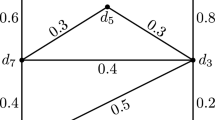Abstract
We define a cellular assignment graph to model the channel assignment problem in a cellular network where overlapping cell segments are included in the model. Our main result is the Capacity-Demand Theorem which shows a channel assignment function is always possible unless there is a connected subregion of cells and overlap segments containing more channel requests then the total capacity of all transceivers within or on the boundary of the subregion and covering any part of the subregion with an overlapping segment. We further describe the simplicity and regularity of our proposed cellular assignment graphs and their accessibility for simulation and theoretical investigation without artifacts from the overall geographical region boundaries.
Similar content being viewed by others
References
H.C. Cankaya, M. Iridon and D.W. Matula, Performance analysis of a graph model for channel assignment in a cellular network, in: COMPSAC (1999).
L.R. Ford, Jr., and D.R. Fulkerson, Flows in Networks (Princeton University Press, 1962).
J. Hale, Frequency assignment, IEEE Proceedings 68(12) (December 1980).
P. Hall, On representatives of subsets, Journal of the London Mathematical Society 10 (1935) 26–30.
M. Iridon and D.W. Matula, Simulating cellular system behavior without boundary effects by embedding the network model on a torus, in: Proceedings of the ICCCN 1998, Lafayette, LA (1998).
M. Iridon, Regular triangulated toroidal graphs with applications in cellular and interconnection networks, Ph.D. Thesis, Southern Methodist University (1999).
I. Katzela and M. Naghshineh, Channel assignment schemes for cellular mobile telecommunication systems: A comprehensive survey, IEEE Personal Communications (June 1996).
V.H. MacDonald, AMPS: The cellular concept, The Bell System Technical Journal 58(1) (January 1979) 5–41.
D.W. Matula, M. Iridon, C. Yang and H.C. Cankaya, A graph theoretic approach for channel assignment in cellular networks, in: 2nd International Workshop on Discrete Algorithms and Methods for Mobile Computing and Communications (1998). In conjunction with ACM/IEEE Mobicom 1998.
E.M. Palmer, Graphical Evolution, An Introduction to the Theory of Random Graphs, Wiley-Interscience Series in Discrete Mathematics (1985).
G.P. Pollini, Trends in handover design, IEEE Communications Magazine (March 1996).
C. Yang, A multi-layer design and load sharing algorithm for personal communication networks, Ph.D. Thesis, Southern Methodist University (1991).
C. Yang and D.W. Matula, Multi-layered arrangement for load sharing in a cellular communication system, U.S. Patent #5,633,915 (May 1997).
Author information
Authors and Affiliations
Rights and permissions
About this article
Cite this article
Iridon, M., Matula, D. & Yang, C. A Graph Theoretic Approach for Channel Assignment in Cellular Networks. Wireless Networks 7, 567–574 (2001). https://doi.org/10.1023/A:1012359132263
Issue Date:
DOI: https://doi.org/10.1023/A:1012359132263




